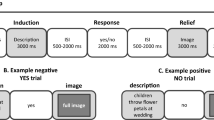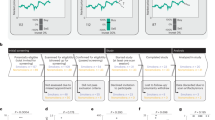Abstract
Addicted individuals pursue substances of abuse even in the clear presence of positive outcomes that may be foregone and negative outcomes that may occur. Computational models of addiction depict the addicted state as a feature of a valuation disease, where drug-induced reward prediction error signals steer decisions toward continued drug use. Related models admit the possibility that valuation and choice are also directed by 'fictive' outcomes (outcomes that have not been experienced) that possess their own detectable error signals. We hypothesize that, in addiction, anomalies in these fictive error signals contribute to the diminished influence of potential consequences. Using a simple investment game and functional magnetic resonance imaging in chronic cigarette smokers, we measured neural and behavioral responses to error signals derived from actual experience and from fictive outcomes. In nonsmokers, both fictive and experiential error signals predicted subjects' choices and possessed distinct neural correlates. In chronic smokers, choices were not guided by error signals derived from what might have happened, despite ongoing and robust neural correlates of these fictive errors. These data provide human neuroimaging support for computational models of addiction and suggest the addition of fictive learning signals to reinforcement learning accounts of drug dependence.
This is a preview of subscription content, access via your institution
Access options
Subscribe to this journal
Receive 12 print issues and online access
$209.00 per year
only $17.42 per issue
Buy this article
- Purchase on Springer Link
- Instant access to full article PDF
Prices may be subject to local taxes which are calculated during checkout




Similar content being viewed by others
References
Redish, A.D. Addiction as a computational process gone awry. Science 306, 1944–1947 (2004).
Lohrenz, T., McCabe, K., Camerer, C.F. & Montague, P.R. Neural signature of fictive learning signals in a sequential investment task. Proc. Natl. Acad. Sci. USA 104, 9493–9498 (2007).
Li, J., McClure, S.M., King-Casas, B. & Montague, P.R. Policy adjustment in a dynamic economic game. PLoS ONE 1, e103 (2006).
O'Doherty, J.P., Buchanan, T.W., Seymour, B. & Dolan, R.J. Predictive neural coding of reward preference involves dissociable responses in human ventral midbrain and ventral striatum. Neuron 49, 157–166 (2006).
Pessiglione, M., Seymour, B., Flandin, G., Dolan, R.J. & Frith, C.D. Dopamine-dependent prediction errors underpin reward-seeking behaviour in humans. Nature 442, 1042–1045 (2006).
O'Doherty, J. et al. Dissociable roles of ventral and dorsal striatum in instrumental conditioning. Science 304, 452–454 (2004).
McClure, S.M., Berns, G.S. & Montague, P.R. Temporal prediction errors in a passive learning task activate human striatum. Neuron 38, 339–346 (2003).
Schultz, W., Dayan, P. & Montague, P.R. A neural substrate of prediction and reward. Science 275, 1593–1599 (1997).
Montague, P.R., Dayan, P. & Sejnowski, T.J. A framework for mesencephalic dopamine systems based on predictive Hebbian learning. J. Neurosci. 16, 1936–1947 (1996).
Montague, P.R., Hyman, S.E. & Cohen, J.D. Computational roles for dopamine in behavioural control. Nature 431, 760–767 (2004).
Daw, N.D. & Doya, K. The computational neurobiology of learning and reward. Curr. Opin. Neurobiol. 16, 199–204 (2006).
Koob, G.F., Sanna, P.P. & Bloom, F.E. Neuroscience of addiction. Neuron 21, 467–476 (1998).
Zhou, F.M., Liang, Y. & Dani, J.A. Endogenous nicotinic cholinergic activity regulates dopamine release in the striatum. Nat. Neurosci. 4, 1224–1229 (2001).
Volkow, N.D., Fowler, J.S. & Wang, G.J. Role of dopamine in drug reinforcement and addiction in humans: results from imaging studies. Behav. Pharmacol. 13, 355–366 (2002).
American Psychiatric Association. Diagnostic and Statistical Manual of Mental Disorders: DSM-IV (Washington, DC: American Psychiatric Association, 2000).
Jarvik, M.E. et al. Nicotine blood levels and subjective craving for cigarettes. Pharmacol. Biochem. Behav. 66, 553–558 (2000).
Wald, N.J., Idle, M., Boreham, J. & Bailey, A. Carbon monoxide in breath in relation to smoking and carboxyhaemoglobin levels. Thorax 36, 366–369 (1981).
Kahneman, D. & Tversky, A. Prospect theory: an analysis of decision under risk. Econometrica 47, 263–291 (1979).
Friston, K.J. et al. Statistical parametric maps in functional imaging: a general linear approach. Hum. Brain Mapp. 2, 189–210 (1995).
Shiffman, S.M. & Jarvik, M.E. Smoking withdrawal symptoms in two weeks of abstinence. Psychopharmacology (Berl.) 50, 35–39 (1976).
Bush, G., Luu, P. & Posner, M.I. Cognitive and emotional influences in anterior cingulate cortex. Trends Cogn. Sci. 4, 215–222 (2000).
Whalen, P.J. et al. The emotional counting Stroop paradigm: a functional magnetic resonance imaging probe of the anterior cingulate affective division. Biol. Psychiatry 44, 1219–1228 (1998).
Damasio, A.R. et al. Subcortical and cortical brain activity during the feeling of self-generated emotions. Nat. Neurosci. 3, 1049–1056 (2000).
Etkin, A., Egner, T., Peraza, D.M., Kandel, E.R. & Hirsch, J. Resolving emotional conflict: a role for the rostral anterior cingulate cortex in modulating activity in the amygdala. Neuron 51, 871–882 (2006).
Keightley, M.L. et al. An fMRI study investigating cognitive modulation of brain regions associated with emotional processing of visual stimuli. Neuropsychologia 41, 585–596 (2003).
Brody, A.L. Functional brain imaging of tobacco use and dependence. J. Psychiatr. Res. 40, 404–418 (2006).
Montague, P.R., King-Casas, B. & Cohen, J.D. Imaging valuation models in human choice. Annu. Rev. Neurosci. 29, 417–448 (2006).
Rosenstein, M.T. & Barto, A.G. in Learning and Approximate Dynamic Programming: Scaling Up to the Real World (eds Si, J., Barto, A., Powell, W. & Wunsch, D.) 359–380 (John Wiley & Sons, New York, 2004).
Frank, M.J., Seeberger, L.C. & O'Reilly, R.C. By carrot or by stick: cognitive reinforcement learning in parkinsonism. Science 306, 1940–1943 (2004).
Hyman, S.E., Malenka, R.C. & Nestler, E.J. Neural mechanisms of addiction: the role of reward-related learning and memory. Annu. Rev. Neurosci. 29, 565–598 (2006).
Nestler, E.J. Molecular mechanisms of drug addiction. Neuropharmacology 47 Suppl 1, 24–32 (2004).
McClung, C.A. et al. DeltaFosB: a molecular switch for long-term adaptation in the brain. Brain Res. Mol. Brain Res. 132, 146–154 (2004).
Marttila, K., Raattamaa, H. & Ahtee, L. Effects of chronic nicotine administration and its withdrawal on striatal FosB/DeltaFosB and c-Fos expression in rats and mice. Neuropharmacology 51, 44–51 (2006).
Hope, B.T., Nagarkar, D., Leonard, S. & Wise, R.A. Long-term upregulation of protein kinase A and adenylate cyclase levels in human smokers. J. Neurosci. 27, 1964–1972 (2007).
Schepis, T.S., Adinoff, B. & Rao, U. Neurobiological processes in adolescent addictive disorders. Am. J. Addict. 17, 6–23 (2008).
Bickel, W.K. et al. Behavioral and neuroeconomics of drug addiction: competing neural systems and temporal discounting processes. Drug Alcohol Depend. 90 Suppl 1, S85–S91 (2007).
Baker, F., Johnson, M.W. & Bickel, W.K. Delay discounting in current and never-before cigarette smokers: similarities and differences across commodity, sign and magnitude. J. Abnorm. Psychol. 112, 382–392 (2003).
Odum, A.L., Madden, G.J. & Bickel, W.K. Discounting of delayed health gains and losses by current, never- and ex-smokers of cigarettes. Nicotine Tob. Res. 4, 295–303 (2002).
Ohmura, Y., Takahashi, T. & Kitamura, N. Discounting delayed and probabilistic monetary gains and losses by smokers of cigarettes. Psychopharmacology (Berl.) 182, 508–515 (2005).
McClure, S.M., Ericson, K.M., Laibson, D.I., Loewenstein, G. & Cohen, J.D. Time discounting for primary rewards. J. Neurosci. 27, 5796–5804 (2007).
McClure, S.M., Laibson, D.I., Loewenstein, G. & Cohen, J.D. Separate neural systems value immediate and delayed monetary rewards. Science 306, 503–507 (2004).
Botvinick, M.M., Braver, T.S., Barch, D.M., Carter, C.S. & Cohen, J.D. Conflict monitoring and cognitive control. Psychol. Rev. 108, 624–652 (2001).
Heatherton, T.F., Kozlowski, L.T., Frecker, R.C. & Fagerstrom, K.O. The Fagerstrom Test for Nicotine Dependence: a revision of the Fagerstrom Tolerance Questionnaire. Br. J. Addict. 86, 1119–1127 (1991).
Watson, D., Clark, L.A. & Tellegen, A. Development and validation of brief measures of positive and negative affect: the PANAS scales. J. Pers. Soc. Psychol. 54, 1063–1070 (1988).
Kwong, K.K. et al. Dynamic magnetic resonance imaging of human brain activity during primary sensory stimulation. Proc. Natl. Acad. Sci. USA 89, 5675–5679 (1992).
Ogawa, S., Lee, T.M., Kay, A.R. & Tank, D.W. Brain magnetic resonance imaging with contrast dependent on blood oxygenation. Proc. Natl. Acad. Sci. USA 87, 9868–9872 (1990).
Ogawa, S., Lee, T.M., Nayak, A.S. & Glynn, P. Oxygenation-sensitive contrast in magnetic resonance image of rodent brain at high magnetic fields. Magn. Reson. Med. 14, 68–78 (1990).
Friston, K.J., Williams, S., Howard, R., Frackowiak, R.S. & Turner, R. Movement-related effects in fMRI time series. Magn. Reson. Med. 35, 346–355 (1996).
Talairach, J. & Tournoux, P. Co-Planar Stereotaxic Atlas of the Human Brain (Thieme Medical Publishers, New York, 1988).
Ashburner, J. & Friston, K.J. Nonlinear spatial normalization using basis functions. Hum. Brain Mapp. 7, 254–266 (1999).
Acknowledgements
We thank B. King-Casas (supported by the National Institute of Mental Health F32 MH078485) and R. Salas for scientific discussion, the Hyperscan Development Team at Baylor College of Medicine for Network Experiment Management Object (NEMO) software implementation (http://www.hnl.bcm.tmc.edu/nemo), X. Cui and J. Li for xjView image viewing and presentation software (http://people.hnl.bcm.tmc.edu/cuixu/xjView) and C. Bracero, J. McGee and S. Moore for technical assistance. This work was supported by the Kane Family Foundation (P.R.M.), the US National Institute on Drug Abuse (R01 DA11723 to P.R.M.), the US National Institute of Neurological Disorders and Stroke (R01 NS045790 to P.R.M.), the Angel Williamson Imaging Center and the American Psychological Association (T32 MH18882 to P.H.C.).
Author information
Authors and Affiliations
Corresponding author
Supplementary information
Supplementary Text and Figures
Supplementary Figures 1 and 2, Tables 1–3, and Methods (PDF 394 kb)
Rights and permissions
About this article
Cite this article
Chiu, P., Lohrenz, T. & Montague, P. Smokers' brains compute, but ignore, a fictive error signal in a sequential investment task. Nat Neurosci 11, 514–520 (2008). https://doi.org/10.1038/nn2067
Received:
Accepted:
Published:
Issue Date:
DOI: https://doi.org/10.1038/nn2067
This article is cited by
-
Nicotine-related beliefs induce dose-dependent responses in the human brain
Nature Mental Health (2024)
-
Chronic nicotine increases midbrain dopamine neuron activity and biases individual strategies towards reduced exploration in mice
Nature Communications (2021)
-
Computational Mechanisms of Addiction: Recent Evidence and Its Relevance to Addiction Medicine
Current Addiction Reports (2021)
-
Short-term mindfulness practice attenuates reward prediction errors signals in the brain
Scientific Reports (2019)
-
Let’s Open the Decision-Making Umbrella: A Framework for Conceptualizing and Assessing Features of Impaired Decision Making in Addiction
Neuropsychology Review (2019)



